
Have you ever encountered the frustrating situation of pulling your laundry out of the washer only to find a tangled mess of clothes? It’s both time-consuming and annoying to untangle them, not to mention the potential damage to your favorite garments. Luckily, there are simple steps you can take to prevent this from happening. By following a few easy tips and tricks, you can ensure that your clothes come out of the washer knot-free and ready to wear. Say goodbye to tangles and hello to hassle-free laundry days!

Proper Loading Techniques
No one wants to deal with tangled, damaged clothes after doing the laundry. By following these proper loading techniques, you can ensure that your garments come out of the washer in great condition.
Separate Delicates and Heavy Fabrics
When loading your washer, it’s important to separate delicate items and heavy fabrics. Delicate items require more gentle treatment, and mixing them with heavier fabrics can cause the delicates to become tangled or damaged. By separating these types of garments, you can prevent any mishaps and keep your clothes in their best condition.
Turn Garments Inside Out
Turning your garments inside out before placing them in the washer has multiple benefits. Firstly, it helps to protect any sensitive or delicate areas of the clothing, such as buttons, zippers, or lace, from potential damage. Secondly, it can help reduce color fading, as the outer layer of the garment is less exposed to direct contact with water and detergent. Turning your clothes inside out is a simple yet effective technique to preserve their longevity and keep them looking their best.
Zip Up Zippers and Button Buttons
It’s easy to overlook zippers and buttons when loading the washer, but neglecting to secure them can lead to damage to both the garments themselves and the washing machine. Open zippers can snag onto other items, causing them to become tangled, while unbuttoned buttons can get twisted or pulled during the wash cycle. Taking a few seconds to zip up zippers and button buttons can save you from potential frustration and ensure that your clothes come out unscathed.
Fasten Hooks and Velcro
Similarly to zippers and buttons, hooks and Velcro should also be fastened before starting the wash cycle. These fasteners have a tendency to grab onto fabrics, causing snags or rips. By ensuring that all hooks are closed and Velcro is secured, you can protect not only the garments themselves but also other items in the load. It’s a simple step that can prevent a great deal of frustration and potential damage.
Use a Mesh Laundry Bag
For extra delicate items or those small enough to get easily lost or tangled, using a mesh laundry bag is a great solution. These bags provide a protective barrier for your most delicate clothing, ensuring that they don’t get tangled with other garments or damaged in the washing machine. Simply place the delicate items inside the mesh bag, zip it up, and then toss it into the washer. This simple tool can make a big difference in preserving the quality of your clothes.
Use the Right Laundry Cycle
Choosing the appropriate laundry cycle for your clothes is essential in preventing tangling and damage. By following these tips, you can ensure that your garments are washed with care.
Choose the Delicate Cycle
The delicate cycle is specifically designed for more fragile fabrics, such as lace, silk, or cashmere. It uses a slower, gentler agitation and a shorter wash time, reducing the risk of tangling or tearing delicate items. Whenever possible, opt for the delicate cycle when washing your more fragile garments to ensure they receive the care they deserve.
Avoid Overloading the Washer
One of the most common causes of tangling in the washer is overloading the machine. When clothes are crammed together, they have less room to move freely, increasing the chances of tangling and knotting. Be mindful of the washer’s load capacity and avoid overloading it. If necessary, split the load into smaller batches to allow for proper water and detergent distribution, as well as better movement of the fabrics.
Use a Low Spin Speed
The spin speed of the washer can play a significant role in the tangling of clothes. High spin speeds generate strong centrifugal forces, which can be problematic for delicate or loosely woven items. Select a low spin speed option on your washer to minimize the chances of tangles and ensure a more gentle treatment of your clothing.
Select a Cycle for Mixed Fabrics
If you have a mixed load of different fabric types, it’s important to choose the appropriate cycle. Many modern washers offer specific cycles for mixed fabrics, which adjust the agitation, spin speed, and duration to accommodate different materials. By using the right cycle for mixed fabrics, you can minimize the risk of tangling and ensure that each garment is treated properly.

Avoid Mixed Loads
One of the best ways to prevent clothes from getting tangled in the washer is to avoid mixing different types of garments. By separating items based on fabric type, color, and similar material, you can greatly reduce the chances of tangling and potential damage.
Separate Items Based on Fabric Type
Different fabrics require different washing methods, and they can behave differently in the washer. Separating your garments based on fabric type allows each material to receive the appropriate care it needs. For example, delicate fabrics, such as silk or lace, are best washed separately from sturdier fabrics, like denim or towels. By separating items based on fabric type, you can avoid potential tangling and ensure that each piece is treated properly.
Sort by Color and Similar Material
In addition to separating items based on fabric type, sorting by color and similar material is also highly recommended. This prevents any potential color bleeding and ensures that similar fabrics are washed together, minimizing the risk of tangling. It’s always a good idea to wash dark-colored items separately from light-colored ones to avoid any unwanted color transfer. Taking the time to sort your laundry may seem tedious, but it can save you from potential mishaps and prolong the lifespan of your clothes.
Prevent Small Items from Tangling
Small items, such as socks or underwear, are notorious for tangling and getting lost in the washer. To prevent this, it’s a good practice to use a laundry bag specifically designed for small items. This bag ensures that these smaller garments stay together, reducing the chances of tangles and eliminating the need for rummaging through the washer to find any missing items. By taking precautions with small items, you can make your laundry routine more efficient and keep track of all your garments.
Take Precautions with Long and Thin Items
Long and thin items, such as belts, straps, or sashes, require special attention to prevent tangling or damage during the wash cycle. By following these tips, you can ensure that these items come out of the washer in perfect condition.
Secure Loose Belts and Straps
Before placing any garments with loose belts or straps into the washer, it’s essential to secure them properly. Loose belts can get caught on other items, while straps can become tangled or twisted, potentially causing damage. Take a moment to secure any loose belts with a safety pin or by tying them tightly. For garments with straps, consider using clothespins or safety pins to keep them in place. By securing these long, loose items, you can prevent them from tangling and ensure a successful wash.
Bundle Up Long Items
Long items, such as bathrobes, dresses, or gowns, have a higher risk of tangling due to their length. To prevent this, it’s helpful to bundle up these garments before placing them in the washer. Simply twist the garment into a loose bundle, securing any loose ends with rubber bands or fabric ties. By bundling up long items, you reduce the chances of them getting caught or tangled with other clothes, ensuring a smoother washing process.
Use a Long Garments Bag
For extremely long or delicate items, such as long dresses or formal gowns, using a long garments bag is highly recommended. These specialized bags are designed to protect delicate garments during the wash cycle, ensuring that they remain untangled and unharmed. Place the long item inside the bag, zip it up, and then insert it into the washer. By using a long garments bag, you can enjoy the convenience of machine washing while keeping your special items safe.

Tie Up Loose Drawstrings and Sashes
Drawstrings and sashes can become tangled or knotted during the wash cycle if left loose. Before loading any items with drawstrings or sashes into the washer, be sure to tie them securely. This prevents them from getting caught on other clothes, reducing the risk of tangling and potential damage. Taking a few extra moments to tie up loose drawstrings and sashes can save you from headaches and ensure that your garments come out of the washer in great condition.
Wash Bulky Items Carefully
Bulky items, such as blankets, comforters, or pillows, require special attention when being washed. By following these tips, you can wash them safely and prevent tangling or damage.
Wash One Bulky Item at a Time
To ensure effective cleaning and prevent tangling, it’s best to wash bulky items one at a time. These items often take up a significant amount of space in the washer, leaving little room for other clothes to move freely. By washing them individually, you allow the bulky item to have the attention and space it needs for a thorough wash without causing any tangling or damage to other garments.
Keep Bulky Items on Their Own
In addition to washing bulky items one at a time, it’s also crucial to keep them separate from other clothing. Mixing bulky items with regular-sized garments increases the chances of tangling, as the heavier and larger items can easily snag onto smaller ones. When you have bulky items to wash, it’s best to dedicate an entire load just for them. This ensures they have ample space to move around freely without the risk of tangling or causing damage to other clothes.

Avoid Overloading the Washer
To prevent tangling and other laundry mishaps, it’s essential to understand the load capacity of your washer and follow the guidelines provided by the manufacturer. Overloading the washer is a common mistake that can lead to tangling, poor cleaning results, and potential damage. By following these tips, you can avoid overloading your washer and maintain its optimal performance.
Follow Washer’s Load Capacity Guidelines
Each washer has a specific load capacity, which indicates the maximum amount of laundry it can effectively clean without sacrificing performance or damaging clothes. To avoid overloading, familiarize yourself with the load capacity of your washer. This information can usually be found in the user manual or on the manufacturer’s website. By adhering to the load capacity guidelines, you ensure a thorough and efficient wash while preventing tangling or damage to your clothes.
Leave Some Space Inside the Washer
Leaving a little space inside the washer when loading your laundry is crucial for the proper circulation of water and detergent. Overstuffing the washer does not allow adequate movement of the clothes during the wash cycle, increasing the risk of tangling and poor cleaning results. To ensure that your garments are evenly cleaned and have enough space to move, aim to fill the washer to about 75% capacity. This allows for proper water distribution and better agitation, reducing the risk of tangling and improving the overall wash quality.
Use Fabric Softener
Fabric softener can be a game-changer when it comes to preventing tangling in the washer. It reduces friction between garments, resulting in less tangling and reduced static electricity. By following these tips, you can make the most of fabric softener and enjoy tangle-free laundry.
Reduce Friction and Static
Fabric softener acts as a lubricant, reducing friction between clothes as they move in the washer. This significantly minimizes the chances of tangling and knotting. Additionally, fabric softener helps eliminate static electricity, which can also contribute to clothing tangling together. When using fabric softener, be sure to follow the manufacturer’s instructions and add the appropriate amount to your wash cycle. By using fabric softener, you can make your laundry routine smoother and tangle-free.

Regularly Maintain the Washer
Proper maintenance of your washer is essential not only for its longevity but also for preventing potential issues that can lead to tangling or damage to your clothes. By following these maintenance tips, you can keep your washer in optimal condition.
Check for Loose Agitator or Impeller
If your washer has an agitator or impeller, it’s important to periodically check for any signs of looseness. These components are responsible for the movement and agitation of the clothes during the wash cycle. A loose agitator or impeller can cause clothes to twist or get caught, leading to tangles or damage. If you notice any wobbling or looseness, consult the manufacturer’s instructions for guidance on how to tighten or fix the issue. Regular inspections can help identify potential problems before they cause harm to your garments.
Clean the Washer Drum
The build-up of detergent residue, lint, and other debris inside the washer drum can negatively impact the washing process and increase the chances of tangling. Regularly cleaning the washer drum is crucial for maintaining its efficiency and preventing any issues. Follow the manufacturer’s instructions for cleaning the drum and use appropriate cleaning agents. By keeping the washer drum clean, you ensure optimal performance and a tangle-free laundry experience.
Carefully Remove Clothes from the Washer
Even after taking all the necessary precautions, clothes can still get tangled in the washer. Properly removing them can prevent further tangling and ensure that your garments come out of the laundry in excellent condition.
Gently Untangle Clothes When Removing
If you notice any tangled clothes when taking them out of the washer, it’s crucial to handle them with care. Gently untangle the garments, being mindful not to pull or yank on them. Trying to force tangled clothes apart can cause damage to the fabric or stitching. Take your time and patiently separate any tangled items to avoid any unnecessary damage or frustration.
Shake Out Clothes before Transferring to the Dryer
Before transferring your clothes to the dryer, give them a good shake to remove any excess water and untangle any loose threads. This simple act can go a long way in preventing tangling and making the drying process more efficient. By shaking out your clothes, you help them regain their natural shape and ensure that they dry evenly.
By following these proper loading techniques, choosing the right laundry cycle, avoiding mixed loads, taking precautions with long and thin items, washing bulky items carefully, avoiding overloading the washer, using fabric softener, regularly maintaining the washer, and carefully removing clothes from the washer, you can prevent clothes from getting tangled and keep them in excellent condition. Taking a little extra time and care during the laundry process will ensure that your clothes look their best and last longer. Happy washing!


